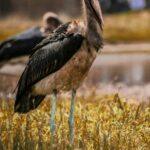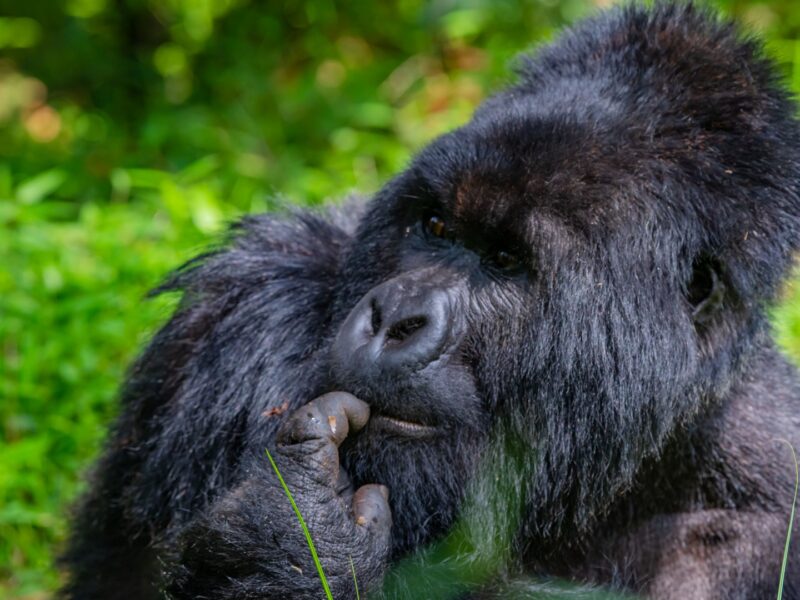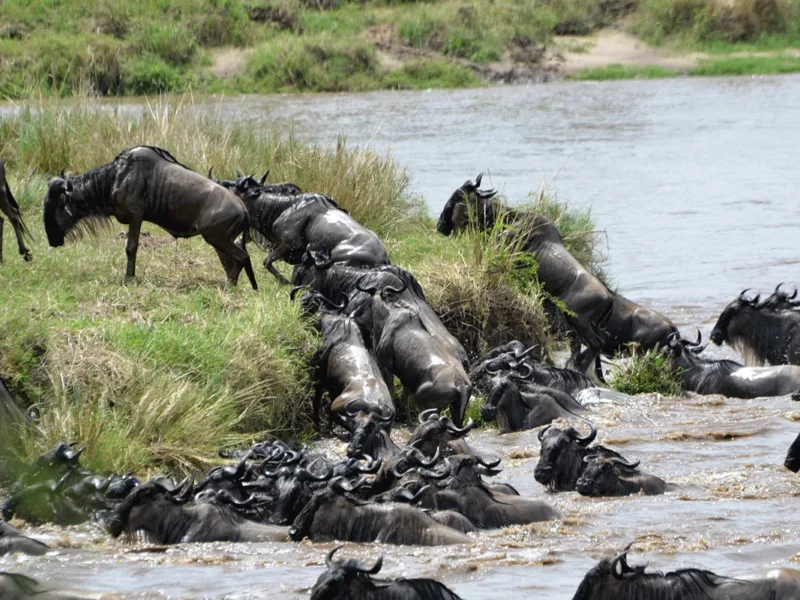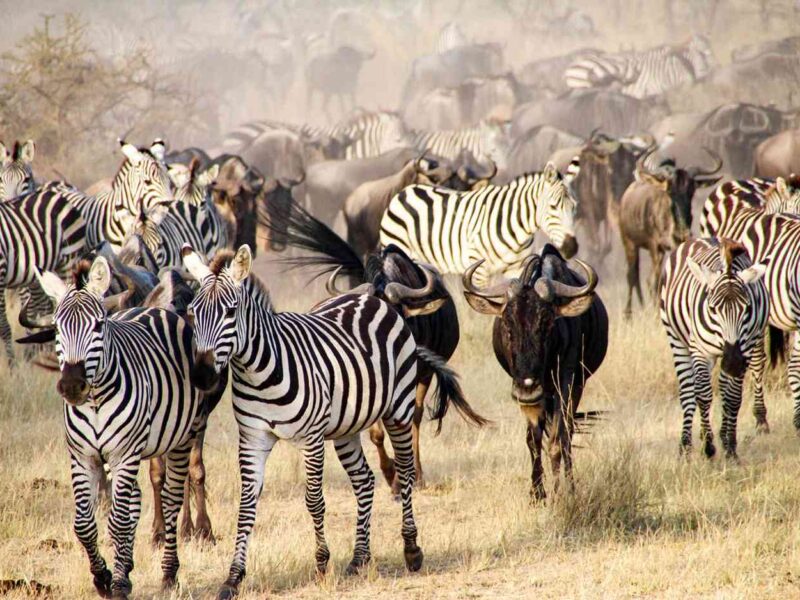
The Marabou Stork in Uganda
September 23, 2025Best Time to Visit Tanzania for Safaris
September 23, 2025
Facts About the Grey Crowned Crane
Uganda’s National Bird
The Pride of Uganda
The Grey Crowned Crane stands as one of Africa’s most elegant and symbolic birds, capturing the admiration of birders, photographers, and safari travellers.
Recognized as the national bird of Uganda, it occupies a special place in the nation’s heritage and is proudly displayed on the national flag and coat of arms.
Its graceful movements, crowned golden plumage, and unique behaviours make it a highlight for those exploring East Africa.
Travelers often begin with questions such as When to go for a Uganda gorilla safari? Where to stay on a Kenya birding safari? What to pack for a Kenya safari?
These questions reflect how visitors want to combine experiences of primates, big game, and birding.
The Grey Crowned Crane adds beauty to this blend, offering unforgettable sightings in wetlands, grasslands, and farmlands.
At Ngeye Tours and Travel, we ensure safari packages highlight both iconic species like gorillas and elegant birds like the crane.

Grey Crowned crane
Appearance and Behaviour of the Grey Crowned Crane
The Grey Crowned Crane is instantly recognizable due to its striking features.
Standing at around 3.3 feet tall, it has a body covered in grey plumage with striking white wings that feature touches of gold and brown.
Its most distinctive feature is the crown of stiff golden feathers adorning its head, giving the bird an almost royal presence in the African landscape.
A bright red throat pouch adds a splash of colour, while long legs and a slender neck give it elegance when walking through grasslands.
Behaviourally, the Grey Crowned Crane is fascinating to watch. Unlike most cranes, it can perch in trees thanks to its long hind toe.
Its courtship displays include intricate dances, synchronized calls, and elaborate bows, all of which delight birding enthusiasts.
Birdwatchers who combine Uganda gorilla trekking with birding adventures in Queen Elizabeth National Park or LLake Mburo National Park often witness these displays during morning game drives.
The bird’s unique behaviours not only enrich birding checklists but also offer cultural insights into how Ugandans value grace, harmony, and resilience.
Habitat and Distribution in East Africa
The Grey Crowned Crane thrives in a variety of habitats across East and Southern Africa.
In Uganda, it is most commonly found in wetlands, grasslands, and agricultural areas.
National parks such as Queen Elizabeth, Murchison Falls, and Lake Mburo host healthy populations.
Their presence in rural farmlands connects them closely with communities, as they often forage for seeds, insects, and small vertebrates near villages.
In Kenya, the crane also appears in wetlands and savannahs, making it a regular sight on Kenya birding safaris.
Travelers exploring Lake Naivasha , Amboseli, or the Great Rift Valley soda lakes often spot flocks feeding gracefully along shores.
Combining gorilla trekking in Uganda with Kenyan birding tours creates a rewarding itinerary that balances primates, big game, and avian beauty.
Visitors often ask, Where to stay on a Kenya birding safari? Lodges near bird-rich wetlands provide excellent access to Grey Crowned Crane habitats.
Cultural experiences, such as Maasai community tours near Amboseli or Batwa cultural visits near Bwindi, complement the birding experiences, creating immersive travel stories.
Nesting and Breeding Patterns
The breeding habits of the Grey Crowned Crane are as captivating as its appearance.
These birds build nests in tall grasses or wetland vegetation, using reeds and grasses to create a secure platform above shallow water.
Typically, a pair lays two to four eggs, and both parents share incubation duties.
Chicks are precocial, meaning they can walk soon after hatching, allowing them to follow parents in search of food almost immediately.
Courtship displays remain a highlight for birding travellers. The dances include elaborate leaps, bowing, wing flaps, and synchronized calls.
These displays reinforce pair bonds, as cranes are monogamous and often form lifelong partnerships.
Observing such behaviours during birding safaris enhances the cultural appreciation of the crane, as many African traditions associate dancing cranes with joy, unity, and prosperity.
When travellers plan Uganda gorilla safaris, they often wish to experience more than primates.
Including birdwatching in national parks where Grey Crowned Cranes thrive gives itineraries additional depth.
Safari lodges around Bwindi and Queen Elizabeth often organize cultural evenings, where dance and music echo the graceful displays of cranes seen during the day.
Diet and Feeding Habits
The Grey Crowned Crane feeds on a varied diet, reflecting its adaptability. It forages for seeds, grasses, small fish, frogs, insects, and worms.
By scratching and probing in the soil, it uncovers hidden prey, while its long beak and slender legs make wetland foraging efficient.
Unlike vultures or marabou storks, the crane does not scavenge, maintaining its elegant feeding patterns.
For safari travellers, watching cranes forage in groups during morning or evening hours offers memorable photography opportunities.
In Uganda, wetlands around Lake Kyoga, Lake Victoria, and Queen Elizabeth National Park provide excellent viewing opportunities. In Kenya, Amboseli National Park and Lake Naivasha are prime locations.
Tourists frequently ask, What to pack for a Kenya safari? Binoculars, telephoto lenses, and lightweight clothing ensure travellers capture the beauty of Grey Crowned Cranes in natural habitats.
At the same time, Uganda safari lodges offer tailored experiences, combining birdwatching, gorilla trekking, and cultural immersion in a seamless itinerary.
Conservation Challenges Facing the Grey Crowned Crane
Despite its symbolic status, the Grey Crowned Crane faces serious threats.
Habitat loss due to wetland drainage, agricultural expansion, and urban development reduces its breeding and feeding grounds.
Illegal trade and egg collection further threaten populations. In Uganda, although protected by law, cranes remain vulnerable because their habitats overlap with farming communities.
Conservation initiatives focus on community education, wetland protection, and legal enforcement.
Organizations partner with Uganda Wildlife Authority to monitor crane populations and engage communities in sustainable farming practices.
Birding tours organized by Ngeye Tours and Travel contribute to conservation awareness by showcasing the crane’s importance to visitors from around the world.
Travelers planning Uganda gorilla trekking often ask, when to go for a Uganda gorilla safari? The dry seasons not only favour gorilla trekking but also enhance crane viewing, as wetlands attract numerous bird species.
Combining gorilla trekking with crane conservation tours ensures meaningful experiences that connect adventure with responsibility.
Cultural Importance of the Grey Crowned Crane
The Grey Crowned Crane is deeply woven into Uganda’s cultural identity.
As the national bird, it symbolizes prosperity, resilience, and peace.
Its image on the coat of arms reflects national pride and unity. In rural traditions, the crane is revered for its beauty and grace, often associated with harmony and good fortune.
Cultural tours offered by safari lodges complement wildlife experiences by exploring these connections.
Guests visiting Batwa communities near Bwindi or pastoralist groups in Uganda’s cattle corridor often hear stories linking cranes to traditional beliefs.
In Kenya, Maasai communities highlight cranes in folklore, aligning the bird’s grace with cultural dance and celebrations.
By combining cultural exploration with Uganda gorilla safaris and birding adventures, travellers gain holistic insights into how wildlife shapes identity and heritage across East Africa.
This cultural immersion elevates safaris from simple wildlife viewing to journeys of meaning and connection.
Planning Your Safari: Grey Crowned Cranes and Beyond
For travellers fascinated by the Grey Crowned Crane, the best safari itineraries combine birding with other iconic wildlife experiences.
Uganda offers gorilla trekking in Bwindi Impenetrable National Park, Chimpanzee in Kibale, and big game drives in Murchison Falls.
Kenya complements this with birding at soda lakes, wildebeest migrations in Masai Mara, and cultural tours in Amboseli. Safari lodges play a central role in these journeys.
Choosing the right accommodation ensures proximity to wetlands for birdwatching and easy access to gorilla trekking points.
Tourists often ask, where to stay on a Kenya birding safari? Lodges near Lake Naivasha or Lake Nakuru provide excellent birding opportunities, while in Uganda, safari lodges near Bwindi and Queen Elizabeth National Park create perfect bases for multi-activity tours.
Packing smart is equally important. Beyond cameras and binoculars, travellers should bring lightweight boots, sun protection, and waterproof clothing.
What to pack for a Kenya safari? is answered by considering both birding and game drives, ensuring comfort in diverse environments.
The Grey Crowned Crane as a Safari Icon
The Grey Crowned Crane embodies the essence of Africa’s elegance and resilience.
As Uganda’s national bird, it carries cultural, ecological, and symbolic importance that resonates with both locals and travellers.
Observing its courtship dances, feeding habits, and wetland movements enriches birding tours, while its symbolic role strengthens cultural immersion.
For travellers planning Uganda gorilla trekking, adding Grey Crowned Crane sightings ensures itineraries are unforgettable.
These safaris showcase Africa’s diversity, combining primates, birds, and cultural encounters.
Ngeye Tours and Travel designs packages that highlight these experiences, answering questions like When to go for a Uganda gorilla safari? What to pack for a Kenya safari? Where to stay on a Kenya birding safari?
By choosing professional guidance and sustainable safari practices, travellers not only witness the beauty of the Grey Crowned Crane but also contribute to conserving Uganda’s natural and cultural heritage.
In every elegant movement of this bird, visitors discover the grace of Africa itself.




